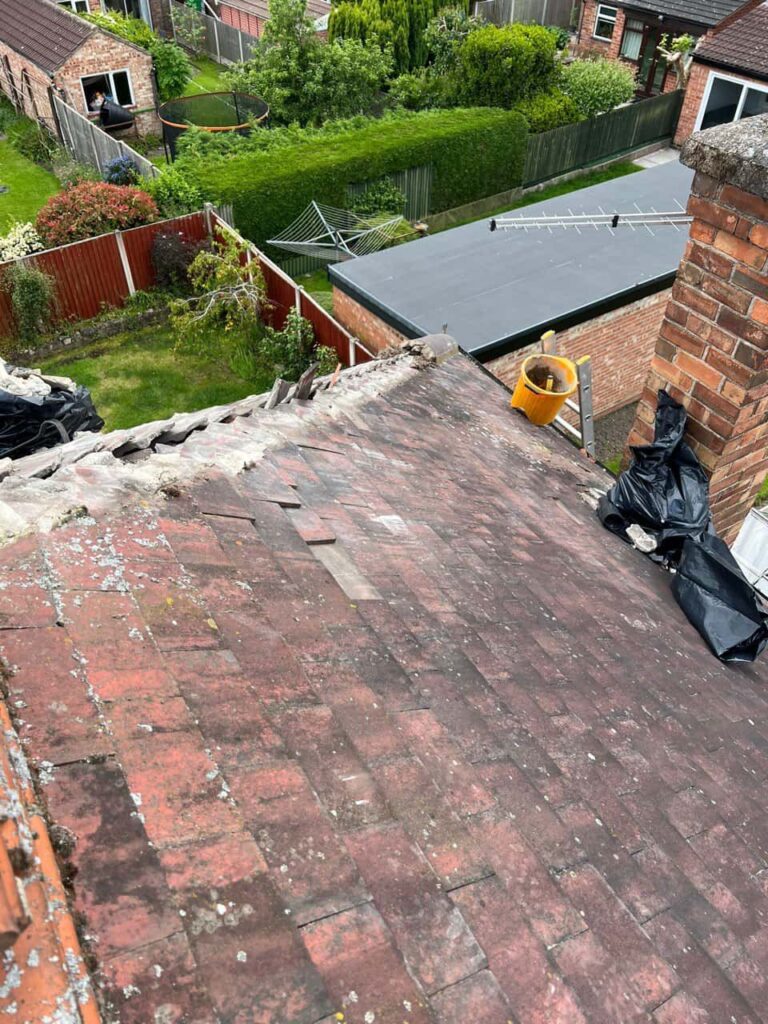A slate roof is a durable and long-lasting option for many homes in Horndean, Hampshire, providing protection from the elements for many years. However, like all roofing systems, it can develop issues over time that may lead to leaks if not addressed promptly. Knowing the signs that your slate roof may be at risk of leaks can help you take action before the problem worsens, saving you from costly repairs and water damage.
In this article, we will explore the common indicators that your slate roof may be vulnerable to leaks and explain why it’s crucial to act quickly to protect your property.
Common Causes of Leaks in Slate Roofs
Slate roofs are known for their longevity, but they are not immune to damage. Over time, weather conditions, wear, and lack of maintenance can compromise the integrity of the slates and their underlying structure. Some of the most common causes of leaks in slate roofs include:
- Cracked or broken slates: A single broken slate can allow water to penetrate, leading to leaks.
- Slipped or displaced slates: Slates that have moved out of position may leave gaps for water to enter.
- Deteriorated roof flashing: Flashing around chimneys, vents, and valleys can deteriorate, causing water to seep through.
- Worn-out underlayment: The material beneath the slates can weaken, losing its ability to protect from moisture.
- Damaged valleys: Valleys, where two roof slopes meet, are particularly vulnerable to water damage if not properly sealed.
Signs Your Slate Roof is at Risk of Leaks
While it’s always best to have a professional roofer assess the condition of your roof, there are several signs you can look for to determine if your slate roof may be at risk of leaking.
1. Missing or Cracked Slates
One of the most obvious signs that your slate roof could be at risk of leaks is the presence of missing or cracked slates. Over time, slates can become brittle, especially after years of exposure to weathering.
- Check for any noticeable gaps or broken slates on your roof.
- Even a single missing slate can allow water to seep in, leading to leaks.
2. Water Stains on the Ceiling or Walls
Water stains on your ceiling or walls, especially after heavy rainfall, are a clear indication that your roof is not keeping water out as it should. If you notice damp patches, peeling paint, or discoloration on your ceiling or walls, it’s essential to inspect your roof for potential leaks.
- Dampness in the attic or upper floors can also point to roof leaks.
- Early intervention can prevent further water damage and more costly repairs.
3. Sagging Roof or Warped Rafters
If your roof appears to be sagging or if the rafters in the attic look warped, it could be a sign of structural damage caused by water infiltration. When leaks persist over time, water can weaken the wooden rafters and support beams, causing them to sag or bend.
- This issue can be dangerous and requires immediate attention from a professional roofer.
4. Broken or Deteriorated Flashing
Roof flashing is a metal strip that helps direct water away from joints, valleys, and chimneys. Over time, flashing can deteriorate or become damaged, allowing water to seep into your roof. This can result in leaks around the edges of chimneys, skylights, or other roof features.
- Check for rust, cracks, or gaps in the flashing around key roof areas.
- Damaged flashing can be repaired or replaced by a roofing expert.
5. Moss, Algae, or Lichen Growth
While some moss and algae growth is normal on older roofs, excessive growth can indicate that water is being trapped on the surface of the slates. This is often a sign of poor drainage or water build-up, which could lead to leaks over time.
- Moss can trap moisture against the roof surface, which can eventually cause the slates to deteriorate.
- Regular maintenance and cleaning can help reduce the risk of moss growth and prevent leaks.
6. Leaks During Heavy Rain or Wind
If you notice that leaks tend to occur specifically during heavy rain or high winds, this is a strong indication that your slate roof is vulnerable. When rain is combined with strong winds, it can force water under broken or misaligned slates, leading to leaks inside your home.
- This could also point to an issue with the roof’s underlayment or flashing.
- Leaks during these conditions are often more noticeable and need immediate repair.
Why Professional Help Is Crucial
While it may be tempting to attempt DIY repairs on your slate roof, it’s important to understand that working on slate roofing requires skill and experience. Incorrect repairs can lead to further damage, more expensive repairs, and potential safety hazards.
At Horndean Roofing Repairs, we specialise in the repair and maintenance of slate roofs in Horndean, Hampshire. Our team of experts can quickly identify the cause of any leaks or damage and provide a long-lasting solution to protect your home.
Why choose us:
- We have extensive experience working with slate roofs and are equipped to handle all types of roofing repairs.
- Our team is fully trained in safe working practices and uses high-quality materials to ensure your roof remains durable and leak-free.
- We offer free, no-obligation roof inspections and can provide advice on how to extend the lifespan of your slate roof.
Conclusion
Your slate roof is a valuable part of your home’s structure and protection, and it’s crucial to identify any potential risks of leaks before they turn into major issues. Regular inspections, prompt repairs, and proper maintenance can help prevent costly damage and ensure the long-term functionality of your roof.
If you suspect your slate roof is at risk of leaks or need professional help in Horndean, Hampshire, contact Horndean Roofing Repairs today. Our experienced team is ready to assist with all your roofing needs, from repairs to maintenance, ensuring your home remains safe, dry, and protected.
Call us on: 023 8235 9799
Click here to find out more about Horndean Roofing Repairs
Click here to complete our contact form and see how we can help with your Roofing needs.

